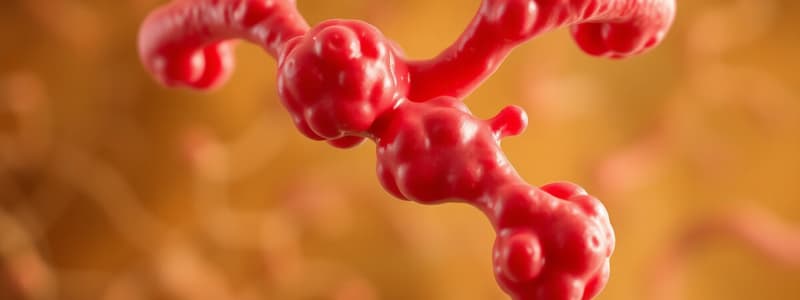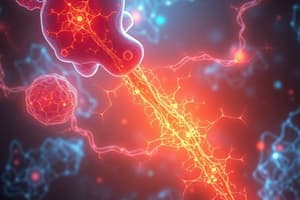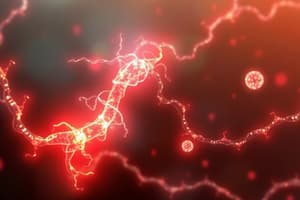Podcast
Questions and Answers
What is a common manifestation of growth hormone deficiency pre-puberty?
What is a common manifestation of growth hormone deficiency pre-puberty?
- Early onset of puberty
- Delayed dental development (correct)
- Increased muscle mass
- Rapid weight loss
Which imaging study is typically used to determine bone age in assessing growth hormone deficiency?
Which imaging study is typically used to determine bone age in assessing growth hormone deficiency?
- MRI
- Ultrasound
- X-ray (correct)
- CT scan
What condition is characterized by GH insensitivity?
What condition is characterized by GH insensitivity?
- Pituitary adenoma
- Acromegaly
- Laron Syndrome (correct)
- Growth hormone excess
What possible consequence arises from lack of growth hormone post-puberty?
What possible consequence arises from lack of growth hormone post-puberty?
Which of the following symptoms is associated with acromegaly?
Which of the following symptoms is associated with acromegaly?
What is a psychological consequence of growth hormone deficiency post-puberty?
What is a psychological consequence of growth hormone deficiency post-puberty?
What is typically used to evaluate the pituitary gland and hypothalamus in cases of growth hormone deficiency?
What is typically used to evaluate the pituitary gland and hypothalamus in cases of growth hormone deficiency?
What is one of the characteristics of gigantism?
What is one of the characteristics of gigantism?
Which demographic is most commonly affected by acromegaly?
Which demographic is most commonly affected by acromegaly?
What is a likely result of severe GH deficiency in childhood?
What is a likely result of severe GH deficiency in childhood?
What is the main function of Insulin-like Growth Factor Binding Proteins (IGFBPs)?
What is the main function of Insulin-like Growth Factor Binding Proteins (IGFBPs)?
Which insulin-like growth factor has the highest homology with insulin?
Which insulin-like growth factor has the highest homology with insulin?
What characterizes growth hormone deficiency pre-puberty?
What characterizes growth hormone deficiency pre-puberty?
What is the effect of growth hormone on glucose metabolism?
What is the effect of growth hormone on glucose metabolism?
Which IGFBP is considered the most abundant?
Which IGFBP is considered the most abundant?
What might a high level of IGFBP-1 indicate in regards to growth?
What might a high level of IGFBP-1 indicate in regards to growth?
What is a notable effect of growth hormone on adipose tissue?
What is a notable effect of growth hormone on adipose tissue?
What is the typical growth velocity for a child with growth hormone deficiency before age 4?
What is the typical growth velocity for a child with growth hormone deficiency before age 4?
Which of the following is a direct effect of growth hormone?
Which of the following is a direct effect of growth hormone?
What role do IGFBPs play in relation to IGF receptors?
What role do IGFBPs play in relation to IGF receptors?
Flashcards
GH's Direct Effects
GH's Direct Effects
Growth Hormone (GH) directly influences various cellular processes, including increasing protein synthesis, enhancing amino acid uptake, and promoting lipogenesis (fat storage).
GH and Protein Metabolism
GH and Protein Metabolism
GH stimulates protein synthesis by increasing amino acid uptake and decreasing protein breakdown, leading to overall increased protein production in the body.
GH and Glucose Metabolism
GH and Glucose Metabolism
GH has a diabetogenic effect, meaning it increases blood glucose levels by decreasing glucose uptake into cells and promoting insulin resistance.
IGF-1
IGF-1
Signup and view all the flashcards
IGF-2
IGF-2
Signup and view all the flashcards
IGFBPs
IGFBPs
Signup and view all the flashcards
IGFBP-3
IGFBP-3
Signup and view all the flashcards
IGFBP-1
IGFBP-1
Signup and view all the flashcards
Growth Hormone Deficiency (Pre-Puberty)
Growth Hormone Deficiency (Pre-Puberty)
Signup and view all the flashcards
Signs of Growth Hormone Deficiency (Pre-Puberty)
Signs of Growth Hormone Deficiency (Pre-Puberty)
Signup and view all the flashcards
Delayed Tooth Development
Delayed Tooth Development
Signup and view all the flashcards
Delayed Pubertal Development
Delayed Pubertal Development
Signup and view all the flashcards
Relative Obesity
Relative Obesity
Signup and view all the flashcards
Hypoglycemia
Hypoglycemia
Signup and view all the flashcards
Laron Syndrome
Laron Syndrome
Signup and view all the flashcards
Genetic IGF Deficiency
Genetic IGF Deficiency
Signup and view all the flashcards
Undersecretion of Growth Hormone Post Puberty
Undersecretion of Growth Hormone Post Puberty
Signup and view all the flashcards
Over-Secretion of Growth Hormone: Pre-puberty
Over-Secretion of Growth Hormone: Pre-puberty
Signup and view all the flashcards
Acromegaly
Acromegaly
Signup and view all the flashcards
Study Notes
Effects of Growth Hormone (GH)
- GH has direct effects on various tissues and organs.
- It increases amino acid (AA) uptake, protein synthesis, and decreases protein breakdown.
- It also affects glucose, leading to increased glucose uptake in some tissues and inhibiting it in others, resulting in a diabetogenic effect (increased blood sugar).
Direct Effects of GH
- GH stimulates lipolysis (breakdown of fat), increasing free fatty acids (FFA) in the blood.
- It inhibits lipogenesis (fat storage).
- GH increases insulin secretion.
- It promotes gluconeogenesis and glycogenolysis (the breakdown of glycogen to glucose) in the liver, which contributes to hyperglycemia (high blood sugar).
- GH promotes protein synthesis in various tissues, and it increases AA uptake.
IGF and Insulin Receptors
- Insulin and IGF-1 receptors share structural similarities.
- Both receptors have alpha and beta subunits.
- IGF-1 receptors have a wider range of effects compared to insulin receptors.
- The IGF-1 receptor activates mitogenic and metabolic pathways.
IGF Family: Receptors and Binding Proteins
- IGF binding proteins (IGFBPs) typically bind IGFs, significantly altering and modifying their activity.
- Different IGFBPs have specific roles in regulating IGF activity.
- IGFBP-3 is the most abundant form, acting as a major carrier of IGFs in the blood.
- It also promotes IGF-mediated somatic growth.
Insulin-like Growth Factor Binding Proteins (IGFBPs)
- IGFBPs bind circulating IGFs with high affinity and specificity.
- They act as carriers of IGFs in plasma.
- They prolong the half-life of IGFs in circulation.
- They regulate IGF access to receptors.
- They function through receptor interaction independently of IGFs.
IGFBPs - Modify IGF Activity
- IGFBP-3 is the most abundant and is a main carrier of IGF in circulation.
- It promotes IGF-mediated somatic growth.
- High IGFBP-3 is associated with growth stimulation.
- IGFBP-1 is present in smaller amounts but is associated with growth inhibition.
Binding Proteins Regulate Free IGF Availability
- The availability of free IGFs to receptors is crucial for development.
- Placental IGF and decidual IGFBP-1 affect levels of free IGF, influencing either shallow implantation, controlled invasion, or unlimited invasion.
Insulin-like Growth Factors - Somatomedins
- IGF-1 is also known as somatomedin C.
- It has 70 amino acids and 50% homology with insulin.
- Stimuli for IGF-1 secretion include GH and nutritional status.
- IGF-2 has 67 amino acids and 70% homology with insulin.
- Nutritional status and GH are stimuli for its secretion.
Bone Cell-Specific Effects of IGFs
- IGFs influence bone cell proliferation.
- They regulate the stem cell pool in the bone marrow and control the differentiation of various bone cells.
- They enhance osteoclast activity via their role in the fusion of osteoclasts.
- They promote osteoblast differentiation and mineralization.
Other Effects of Growth Hormone
- GH stimulates lipogenesis (fat production) in adipose tissue.
- GH influences extra skeletal tissues by promoting cell growth and protein synthesis.
- It has overall effects on blood glucose, increasing plasma levels and decreasing glucose uptake.
- GH impacts insulin resistance and can cause pituitary diabetes.
GH Hormone Deficiency: Pre-Puberty
- A common pituitary hormone deficiency in children; sometimes isolated to just GH or related to deficiencies of other pituitary hormones.
- Severe GH deficiency leads to panhypopituitarism.
- GH deficiency is often associated with slow growth and short stature.
Growth Hormone Deficiency: Pre-puberty (Clinical Features)
- Growth failure; height below the 3rd percentile.
- Growth velocity usually less than 6 cm/year before age 4, less than 5 cm/year from 4-8 years, and less than 4 cm/year before puberty.
- Small stature.
- Normal proportionality between upper and lower body segments.
- Skeletal maturation is two years behind chronological age.
- May include delays in tooth development, pubertal development, relative obesity, and hypoglycemia.
- Manifestations of other endocrine deficiencies could occur.
GH Pre-Puberty Deficiency: Clinical Assessment
- Obtaining height and weight data through charts.
- Imaging studies to assess bone age (using X-rays, typically of the left hand).
- Measuring GH levels through deficiency testing.
- Assessing the level of skeletal maturation and relating it to the level of height.
- Using MRI for investigating the pituitary gland and hypothalamus; looking for abnormalities such as calcifications or tumours.
- Measurement of hormones and binding proteins.
- Stimulation tests (e.g., Arginine) to determine GH response.
Growth Deficiencies Unrelated to GH Deficiency
- Laron syndrome, also known as GH insensitivity or primary IGF-1 deficiency, is a rare genetic disorder.
- Inherited in an autosomal recessive manner.
- Genetic mutations affect the growth hormone receptor gene.
- Defect in the GH and IGF-1 pathway.
- Genetic IGF deficiency and nutritional neglect can also cause growth deficiencies.
Undersecretion Post-Puberty
- GH deficiency in adults leads to metabolic imbalances, increased adiposity, excessive tiredness, cardiovascular diseases, anxiety, depression, and reduced quality of life.
Over-Secretion of GH: Age-Dependent Gigantism (Prepuberty)
- Excessive GH production before puberty leads to gigantism.
Over-Secretion of GH: Post-Puberty (Acromegaly)
- Overproduction of GH after puberty causes acromegaly.
- This is typically caused by a pituitary tumor impacting GH secretion.
Acromegaly (Symptoms)
- Enlargement and thickening of skin and facial features (coarse).
- Enlarged hands, feet, lips, nose, and tongue.
- Jaw protrusion.
- Thickened ribs (barrel chest).
- Organ enlargement; sometimes leading to cardiovascular issues.
- Obstruction of the upper airway and sleep apnea.
- Glucose intolerance – potentially leading to pituitary diabetes.
- General tiredness.
Fetal Growth
- Growth is influenced by many factors.
Studying That Suits You
Use AI to generate personalized quizzes and flashcards to suit your learning preferences.




